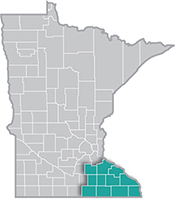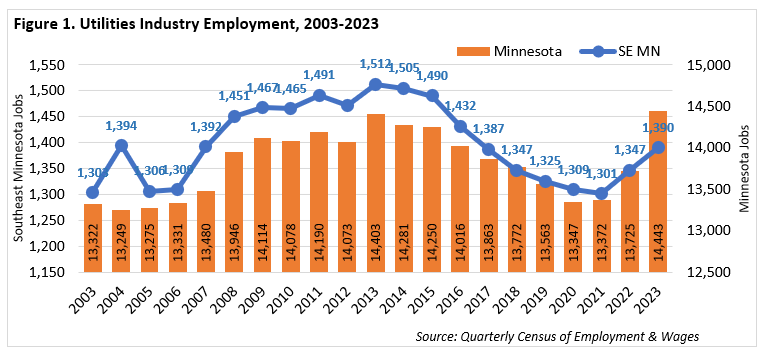 Southeast Minnesota is a health care and agricultural powerhouse. The region is home to the renowned Mayo Clinic and some of the world's most recognized food companies and brands.
Southeast Minnesota is a health care and agricultural powerhouse. The region is home to the renowned Mayo Clinic and some of the world's most recognized food companies and brands.
Advanced manufacturing is especially strong here, with machinery, chemicals, and electronics among the top products.
Want the freshest data delivered by email? Subscribe to our regional newsletters.
1/31/2025 2:22:10 PM
Amanda Blaschko
The Utilities industry forms the foundation of daily life in Southeast Minnesota, providing essential services and infrastructure that power homes, businesses, and communities around the clock. Based on the /deed/data/current-econ-highlights/qcew-econ-highlights.jspQuarterly Census of Employment & Wages (QCEW) data, this industry provided 1,390 jobs across 50 firms in 2023, generating over $192.6 million in total payroll. The industry's average annual wage of $138,632 was more than twice the regional average across all industries ($63,388), reflecting the high-skill, high-wage nature of utility work.
From keeping the lights on through electric power generation and distribution, to delivering natural gas for heating and cooking, to maintaining clean water and sewage systems, these utilities provide the critical infrastructure that enables modern society to function smoothly. These utility workers are playing an increasingly important role as Minnesota works toward its goals of achieving 100% carbon-free electricity and 55% renewable electricity by 2040.
| Table 1. Industry Employment Statistics, 2023 | ||||
|---|---|---|---|---|
| Southeast Minnesota | Number of Jobs | Number of Firms | Total Payroll | Avg. Annual Wage |
| Total, All Industries | 244,024 | 13,603 | $15,470,512,473 | $63,388 |
| Utilities | 1,390 | 50 | $192,659,377 | $138,632 |
| Electric Power Generation, Transmission & Distribution | 1,243 | 33 | $179,087,740 | $144,144 |
| Electric Power Generation | 714 | 13 | $121,501,553 | $170,144 |
| Electric Power Transmission, Control, & Distribution | 528 | 20 | $57,586,187 | $109,044 |
| Natural Gas Distribution | 94 | 9 | $9,012,641 | $95,992 |
| Water, Sewage & Other Systems | 52 | 8 | $4,558,996 | $87,412 |
| Source: Quarterly Census of Employment & Wages | ||||
Southeast Minnesota's Utilities industry employment has experienced ups and downs over the past two decades, but ended with modest job growth, though lagging behind the state's more robust expansion (Figure 1). The region gained 87 jobs between 2003 and 2023, rising modestly by 6.7% from 1,303 to 1,390 jobs. In contrast, Minnesota showed more robust growth, adding 1,121 jobs during the same period, an 8.4% increase, and reaching 14,443 jobs in 2023 - its highest level in the 20-year period.

Southeast Minnesota's employment in the sector peaked at 1,512 jobs in 2013, followed by a gradual decline through 2021 when it bottomed out at 1,301 jobs, though recent years have shown signs of recovery.
While QCEW data provides valuable insights into Utility industry employment through traditional industry classifications, the U.S. Energy and Employment Report (USEER) offers additional perspective of the evolving energy workforce. Produced by the U.S. Department of Energy through an annual survey of approximately 33,000 employers, USEER captures a broader range of energy-related jobs that may be classified under different industries in traditional data sources. This supplemental data tracks employment across five major categories: electric power generation, fuels, transmission/distribution/storage, energy efficiency, and motor vehicles. This comprehensive approach helps identify workforce trends in emerging sectors like renewable energy and energy efficiency that are reshaping the energy landscape but might not be fully captured in conventional utility industry data.
Southeast Minnesota's energy sector shows both stability and transformation. While traditional utility employment has remained steady over the past two decades, the broader energy industry reveals more dynamic changes. The region's strong presence in Energy Efficiency and Motor Vehicles, combined with shifts toward clean fuels and changes in power generation, reflects Minnesota's larger transition toward clean energy goals. As the state progresses toward carbon-free electricity by 2040, the region's energy workforce will likely continue to evolve, creating new opportunities across both traditional and emerging energy sectors.
For more information about energy employment in Southeast Minnesota, contact Amanda Blaschko at amanda.blaschko@state.mn.us or visit CareerForceMN's Find a Job.